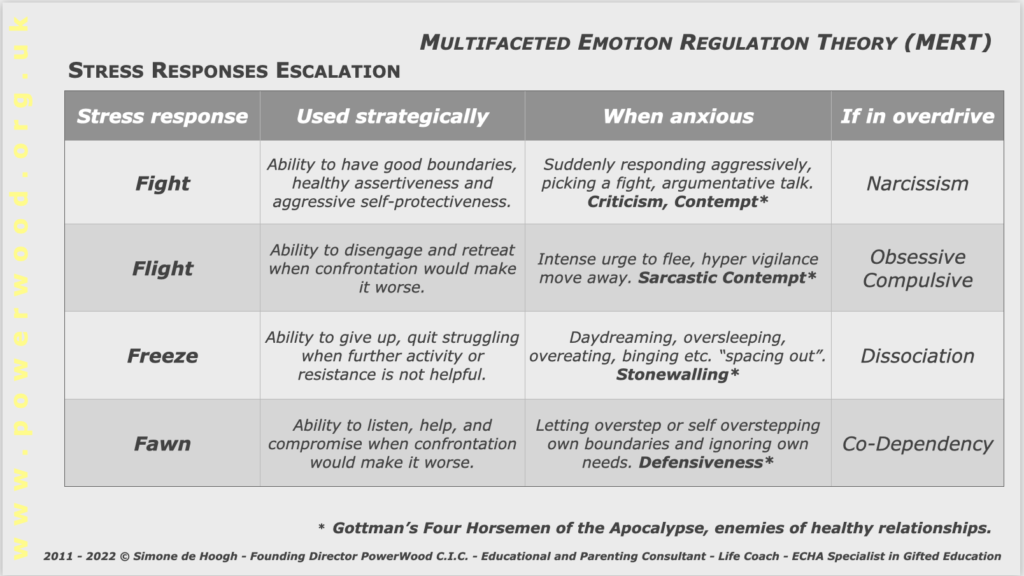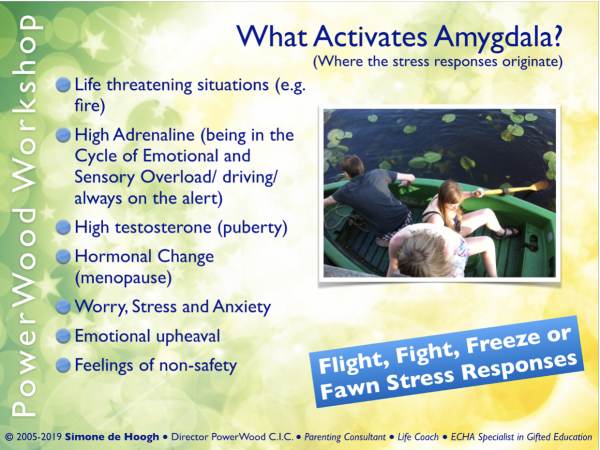
To facilitate access to all, PowerWood articles are also available to non-members. If you enjoy reading the articles please support PowerWood by becoming a PowerWood Community FreeBee or Friend member. Thank YOU!
Please visit for medical health guidelines and regulations your government website and your local healthcare provider website. Thank you.
Our Response to a Crisis…
Stress Responses Explained
These responses developed in order to be able to protect ourselves, survive challenges and give ourselves the best possible start in life. When our feelings of safety are triggered we develop stress responses that might become deeply ingrained in our behaviour, we also inherit the stress response preference from our parents’ dynamic. Later in life, these responses may get in the way of having fulfilling relationships or being able to go after our goals. Stress responses help us to distract or block out inner feelings when we feel overwhelmed.
Overlap Stress Responses and Involuntary Mechanisms
Stress Responses are deeply ingrained in neurological pathways forming Involuntary Mechanisms (IM) that you can recognise by the lack of choice, your actions seem to just happen upon yourself. They are often fuelling our Thinking, Feeling and Doing Loops helping us to postpone feeling.
Stress Responses and Secure Attachment
If you had a secure attachment with your parent(s), you would have developed a healthy and flexible stress response allowing you as an adult to choose the stress response most helpful in the moment, be it facing a wolf, a yelling boss or a traffic jam. The fight response ensures good boundaries, healthy assertiveness and aggressive self-protectiveness if necessary. The flight will help you to disengage and retreat when confrontation would make it worse. You can freeze and give up, quit struggling when further activity or resistance is not helpful. You can fawn in a liquid, “play-space” manner and are able to listen, help and compromise as readily as you assert and express yourself and your needs, rights and points of view.
Stress Responses and ACE’s
Childhood experiences, the modelled family dynamics and our innate abilities play a big part in what type of individual stress response we develop and use most. Adverse Childhood Experiences (ACEs), including regularly being verbally and emotionally abused in the family, might have ingrained your stress response in overdrive and lets it take over even when not really needed so it gets in the way as an Involuntary Mechanism (IM).
A fight stress response has been triggered when someone suddenly responds aggressively to someone/thing that is experienced as frightening and is associated with narcissism.
A flight stress response has been triggered when a perceived threat is met with an intense urge to flee, or emotionally move away from what happened, associated with obsessivity/compulsivity.
A freeze stress response has been triggered when escaping anxiety by daydreaming, oversleeping, overeating, Netflix binging or some other form of “spacing out” associated with dissociation.
A fawn stress response has been triggered when escaping anxiety by completely focusing on someone else and letting our own feelings of well-being depend on someone else’s well-being by trying to remove all obstacles from someone else’s Runway (one of the main concepts in Multilevel Emotion Regulation Theory (MERT)) while ignoring our own needs and overstepping ourselves or letting our own boundaries be overstepped, associated with codependency. (Source)
The most unknown: the fawn stress response is mostly developed by people with emotional OE because of their innate ability to suss out the needs of others. Unfortunately, we can only remove all the obstacles on someone else’s Runway (one of the main concepts in Multilevel Emotion Regulation Theory (MERT)) by completely ignoring our own needs and boundaries.
The term ‘fawn’ stress response was coined by Pete Walker in 2003.
Amygdala (Source)
The amygdala, the primal part of the brain, is an area that contributes to emotional processing of information received. After the amygdala sends a distress signal, adrenaline is pumped into the bloodstream. The heart beats faster than normal, pulse rate and blood pressure go up. The affected person starts to breathe more rapidly. Small airways in the lungs open wide. This way, the lungs can take in as much oxygen as possible with each breath. Extra oxygen is sent to the brain, enabling sight, hearing and other senses to become sharper. Meanwhile, the body releases blood sugar (glucose) and fats supplying energy to all parts of the body.
All of these changes happen so quickly that people aren’t aware of them. In fact, the wiring is so efficient that the amygdala and hypothalamus, which is the area for the brain responsible for releasing hormones and regulating body temperature, start this cascade even before the brain’s visual centres have had a chance to fully process what is happening. That’s why people are able to jump out of the path of an oncoming car even before they think about what they are doing.
As the initial surge of adrenaline subsides, the second component of the stress response system is activated: a series of hormonal signals to keep the sympathetic nervous system — the “gas pedal” — pressed down. If the brain continues to perceive something as dangerous, the hypothalamus triggers the release of cortisol. The body thus stays revved up and on high alert. When the threat passes, cortisol levels fall. The parasympathetic nervous system — the “brake” — then dampens the stress response.

The Four Horsemen of the Apocalypse (Gottman) combined with Stress Responses
When you’re upset and aware that you are in the stress response right in the moment, well done YOU.
If you are not aware, please don’t worry, apply the Awareness Mantra (as described in my blog Overwhelmed by Guilt and Shame while Parenting? Congrats!) as soon as you are aware, even if it is weeks later. This is to prevent any not helpful train of thoughts and to raise awareness, the more you practise and use the mantra, the more ingrained it will become, so that eventually you will automatically remember it in the moment. This in turn leads to just enough time between the trigger and the involuntary reaction to eventually change your behaviour.
If you are aware and able in the moment (if not don’t worry, just apply the Awareness Mantra) try to not react and if possible withdraw and focus on calming yourself e.g. by doing the one-minute 4 – 7- 8 breathing exercise. This will enable you to get back in the director’s chair so you can really think about what you want to achieve in this situation and what steps would be most helpful.
Read on: Overwhelmed by Guilt and Shame while Parenting? Congrats!
Emotional Coronavirus Crisis Guide Articles
- Staying Sane and Connected
- School’s Out – Adjusting to sudden Home-Education
- Our Response to a Crisis – Stress Responses explained
- The Cuddle Alarm (Tool)
To facilitate access to all PowerWood articles are also available to non-members. If you enjoy reading the articles please support PowerWood by becoming a PowerWood Community FreeBee or Friend member. Thank YOU!
PowerWood’s Community
Find understanding, tools and strategies that work in an understanding, respectful and compassionate Community.
PowerWood can be your and your families advocate and your second family.
Explore how joining our PowerWood community by becoming a member will benefit you and your family and what types of memberships are available.
Join our Community
Available to Members*
*Booking a one-off Free Introductory Talk of 45-60 minutes by Skype or FaceTime with Senior Consultant Simone de Hoogh is one of the benefits of being either a FreeBee PowerWood Community Member or a Friend PowerWood Community Member.
Book a FREE Introductory Talk with a Professional*
You can read more about PowerWood’s Consultancy Sessions, the Benefits of a Free Introductory Talk and PowerWood’s Consultancy Services Tiered Fee Structure.
*Overexcitability Test
OE (Overexcitability) is an element of a Developmental Theory –Theory of Positive Disintegration by Dabrowski- that is one of the underpinning theories of MERT (Multi-level Emotion Regulation Theory) developed by Simone de Hoogh. Overexcitability explains and allows us to look at ‘extreme’ behaviour as a valuable asset in our or our children’s life.
Find out if you or your child has OE (OverExcitability) as well
*Boundary Test
A HUGE thank YOU to the son and daughter of Ernest Hartmann’s who gave PowerWood permission to use and put the full academically approved questionnaire about the Boundary in the Mind on PowerWood’s website.
Find out how the Boundary in the Mind affects you or your child

